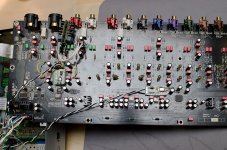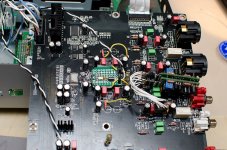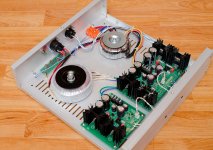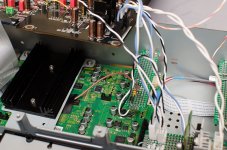not very clever to replace the switching PSU with an analogue one...
I tend to agree with that. But then, with the 103 the best solution post-DAC is to use 1:1 transformer and then you don't need any power supply in that area. Let the SMPS do the rest and fit Murata SMD caps on the Cirrus Logic DAC to deal with the worst noise (yes, even more important than any deficiencies in the SMPS that Oppo uses) - get some decent clocking, and the 103 is really quite good, in fact more than rather good.
Cheers, Joe
I tend to agree with that. But then, with the 103 the best solution post-DAC is to use 1:1 transformer and then you don't need any power supply in that area. Let the SMPS do the rest and fit Murata SMD caps on the Cirrus Logic DAC to deal with the worst noise (yes, even more important than any deficiencies in the SMPS that Oppo uses) - get some decent clocking, and the 103 is really quite good, in fact more than rather good.
Cheers, Joe
I tend to agree with that...
I did actually so... Increased the filtering of the actual SMPS, better clock and improved its PSU, and that`s (almost ) it. The SMPS is in the right place in all Oppo players model. When quite high currents are needed in circuits, then a SMPS is the best solution. The player enclosure it not can reasonable deal with the generated heat of a analogue PSU for entire device.
The only problem in this area is the quite high HF noises this PSU it radiate on the wires, and into the circuits. A better filtering it solve the problem... A better clock is also a must to get a higher quality out of the player...
Here it is, my version of mods on oppo 95 based on Coris and Joe experiences. Thank you all for being generous with shearing your knowledge.
It used to be love/hate relationship with my stock oppo 95. Love because of it's functionality and hate because of the sound. Never liked oppo 95 sound character because in my opinion it suffered from "digitisis", harshness, flat sounding, uninvolved etc... (my reference is Marantz SA-11S1). It's worth mentioning that these mods were done over Modwright so called "Solid State 2channel" mod.
what I've done:
list sorted in importance order (the most affect on sound):
- Burson opamp for SE stereo
- Separate linear PSU unit for +/-15v and +9.5v (design: AMB Laboratories DIY Audio Site)
- DAC oscillators (right now I'm having SAW 100MHz 50ppm on stereo and cheaper FOX 100MHz 25ppm on M-channel)
- 25MHz Connor Winfield 0.5ppm oscillator on main board.
- Belleson reg 3.3v for oscillators.
The biggest surprise was expensive CW 0.5ppm 25MHz oscillator which clearly improved video but sound become "slow", lighter in balance and lost "meat off a bones", although there was more details. That was done before changing dac oscillators, which brought back "all that was lost".
Right now I'm awaiting delivery of CW 100MHz 1ppm and will install it on stereo and see how things change.
P.S. any comments welcome
It used to be love/hate relationship with my stock oppo 95. Love because of it's functionality and hate because of the sound. Never liked oppo 95 sound character because in my opinion it suffered from "digitisis", harshness, flat sounding, uninvolved etc... (my reference is Marantz SA-11S1). It's worth mentioning that these mods were done over Modwright so called "Solid State 2channel" mod.
what I've done:
list sorted in importance order (the most affect on sound):
- Burson opamp for SE stereo
- Separate linear PSU unit for +/-15v and +9.5v (design: AMB Laboratories DIY Audio Site)
- DAC oscillators (right now I'm having SAW 100MHz 50ppm on stereo and cheaper FOX 100MHz 25ppm on M-channel)
- 25MHz Connor Winfield 0.5ppm oscillator on main board.
- Belleson reg 3.3v for oscillators.
The biggest surprise was expensive CW 0.5ppm 25MHz oscillator which clearly improved video but sound become "slow", lighter in balance and lost "meat off a bones", although there was more details. That was done before changing dac oscillators, which brought back "all that was lost".
Right now I'm awaiting delivery of CW 100MHz 1ppm and will install it on stereo and see how things change.
P.S. any comments welcome
Attachments
Last edited:
Hi Qkizz
I can see that was quite a lot of work on your player...
To be a little bit critic, I will say that are quite many and long enough wires all around your moded areas. In my opinion this is not very fortunate, specially when about oscillators. You may find some solutions to solder the oscillators very near to the involved circuits, without any board in between, and with less as possible long wire connections.
Such long wires (few cm are also long wires...) one may prevent too, when about opamps or so in analogue post DAC processing....
Now, when you have in place your mods, and you are satisfied with the sound, you may try the last (large discussed here and enough controversial...) mod for the sound stage: the cap over the output phases of the DAC chip (or I/V inputs).
Here is unfortunately no any particular suggested value for these caps. You may experiment on your own on your device. But there is about an nF range, small, SMD or so, film caps.
When about the heat sink for the main processor, I will suggest you to remove the iron plate inn between the processor chip and the alu heat sink (your picture). You can use the original plate over the processor to press the alu heat sink which it may be in direct contact with the chip (but not in contact with some other around components... ). Please take a look at my pictures in the beginning of the thread here. So the heat transfer it could be more efficient, lowering even more the processor temperature.
). Please take a look at my pictures in the beginning of the thread here. So the heat transfer it could be more efficient, lowering even more the processor temperature.
Better cooling for the main processor in 95 model it brings alone quite important improvements in both sound and picture.
Else is right that 95 it sounds quite flat and non involving as it is out of the factory...
I can see that was quite a lot of work on your player...
To be a little bit critic, I will say that are quite many and long enough wires all around your moded areas. In my opinion this is not very fortunate, specially when about oscillators. You may find some solutions to solder the oscillators very near to the involved circuits, without any board in between, and with less as possible long wire connections.
Such long wires (few cm are also long wires...) one may prevent too, when about opamps or so in analogue post DAC processing....
Now, when you have in place your mods, and you are satisfied with the sound, you may try the last (large discussed here and enough controversial...) mod for the sound stage: the cap over the output phases of the DAC chip (or I/V inputs).
Here is unfortunately no any particular suggested value for these caps. You may experiment on your own on your device. But there is about an nF range, small, SMD or so, film caps.
When about the heat sink for the main processor, I will suggest you to remove the iron plate inn between the processor chip and the alu heat sink (your picture). You can use the original plate over the processor to press the alu heat sink which it may be in direct contact with the chip (but not in contact with some other around components...
Better cooling for the main processor in 95 model it brings alone quite important improvements in both sound and picture.
Else is right that 95 it sounds quite flat and non involving as it is out of the factory...
Last edited:
Thanks Coris for your comments. 
All duly noted!
Yes, I was thinking of shortening wires from oscillators to dac but soldering directly to pin 24 of ES9018 is way too risky for me. Tried it already and it didn't end up too well . Mounting oscillators on boards also allows me to move it around easily as it's not really that permanent. Once I'll settle down with combination of oscillators I like, I'll make connection as short as possible.
. Mounting oscillators on boards also allows me to move it around easily as it's not really that permanent. Once I'll settle down with combination of oscillators I like, I'll make connection as short as possible.
Processor 25Mhz clock is connected with about 6cm of 50ohm mini coax. Judging from how all commercial clocks like Superclock etc. are using coax to extend connection I thought it's fine.
100MHz is probably different story and the question would be if using lets say short piece of coax (+/- 3cm) would still be acceptable???
All in all the player is totally different beast right now. All pleasure to listen to stereo or multichannel.
"You can use the original plate over the processor to press the alu heat sink" - great idea!!!!
Thanks again!!!
All duly noted!
Yes, I was thinking of shortening wires from oscillators to dac but soldering directly to pin 24 of ES9018 is way too risky for me. Tried it already and it didn't end up too well
Processor 25Mhz clock is connected with about 6cm of 50ohm mini coax. Judging from how all commercial clocks like Superclock etc. are using coax to extend connection I thought it's fine.
100MHz is probably different story and the question would be if using lets say short piece of coax (+/- 3cm) would still be acceptable???
All in all the player is totally different beast right now. All pleasure to listen to stereo or multichannel.
"You can use the original plate over the processor to press the alu heat sink" - great idea!!!!
Thanks again!!!
I have not exactly figures (I do not know in details 103 model), but on 5v it may take few amps. That because is not very clever to replace the switching PSU with an analogue one...
At least it may not be very difficult to measure the current needed of the 103 internal stages...
I have one of Jaehong Lee's linear PSU's fitted. I'm thinking of upgrading the caps. The same PSU is for the 93 and 103. There's no problem at all with heat.
The reason why I was asking about current needs is to explore whether there's flex in better regulators. It is currently using LT1084 for the two 5V rails and LM7815 for the +15V (LM7915 for the -15V but I don't use the -15V because I have removed the analogue section and use it purely as a digital transport).
Last edited:
- get some decent clocking, and the 103 is really quite good, in fact more than rather good.
Cheers, Joe
The clock upgrade would be the next step but I wanted to look at the power supply first in order that the clocks are powered directly from good clean PSU
The clock upgrade would be the next step but I wanted to look at the power supply first in order that the clocks are powered directly from good clean PSU
That is what makes the difference between just a clock and a really good clock.
A totally independent power supply is best - one that is only earthed at the insertion point.
Cheers, Joe
An independent one may be a step too far for a $500 player I use less for audio now. My dedicated audio server with its ESI Juli@ sound card with clocks modified with a Fidelity Audio Micro Clock 2 is the source device for most of my audio now.
Anyway, if there are further thoughts on current needs it would be great. I find it hard to believe the digital board needs two 5V rails at 5A each.
Anyway, if there are further thoughts on current needs it would be great. I find it hard to believe the digital board needs two 5V rails at 5A each.
Guys I would not dismiss changing the SMPS for a linear one. I have Lee Jaehong's LPS and it is a substantial upgrade in sound and visual quality over the standard SMPS. Other people I know who have one report the same effect.
This is not to say mods to the SMPS could end up as good or better, but its handy to have a drop in replacement.
This is not to say mods to the SMPS could end up as good or better, but its handy to have a drop in replacement.
Changing the SMPS with a serial one, it lower the noise level in the system. This is to be seen on the picture and heard in the sound out of the player.
Lowering the noise in the system it can be made in many ways: replacing the SMPS with a analogue one, better filtering on the existing SMPS, shielding, and so on...
Of course a serial PSU is better than a SMPS one. The only advantages of SMPS are increased efficiency and less heat generating (for the currents involved). But one must work more on SMPS to get rid of the HF noises this device as usual generate.
So, one may chose what it may be more convenient to reach its target...
In 95 model it is a problem with the quite high level of heat inside the enclosure. A serial PSU will not contribute at all to get less heat inside the box...
Lowering the noise in the system it can be made in many ways: replacing the SMPS with a analogue one, better filtering on the existing SMPS, shielding, and so on...
Of course a serial PSU is better than a SMPS one. The only advantages of SMPS are increased efficiency and less heat generating (for the currents involved). But one must work more on SMPS to get rid of the HF noises this device as usual generate.
So, one may chose what it may be more convenient to reach its target...
In 95 model it is a problem with the quite high level of heat inside the enclosure. A serial PSU will not contribute at all to get less heat inside the box...
i Have measure the 5v Line. it about. 2.5A,
hi Coris, i saw that you used discrete opamp. what adapter are you using to solder it to the smd pad? it must be a mammoth task.
Sorry for delayed answer, but I have not being here for long time now...
It may be a misunderstanding about discrete opamps. I did not used such...
I am very interested in upgrading the clocks on my Oppo BDP-95. I am fairly handy with a soldering iron and have modded my equipment - I am a modder by hobby, not by trade though. I can mod items based on others recommendations on which parts to use, and where to place the mods. My soldering iron is a Weller WES-51 - I have several tips at my disposal.
My goal is to gain additional sonic potential out of the BDP-95. I am willing to replace diodes, electrolytic caps, and add clocks to the DAC areas if this helps gain a sonic benefit.
Does anyone recommend if a DIY DAC Clock kit is available using a Dexa Clock, Joe R.s Terra Firma clock, or Coris' clock modifications? I seen Coris' clock modifications and notice he adds components on top of the DAC(?) chips which I would be interested in pursuing.
I put in a purchase for an LPM-SE Power Supply to replace the SMPS power supply from Jae Hong Lee.
Sorry if this has been answered already, however I would prefer to go straight for the answer without having to jump through 40 pages.
My goal is to gain additional sonic potential out of the BDP-95. I am willing to replace diodes, electrolytic caps, and add clocks to the DAC areas if this helps gain a sonic benefit.
Does anyone recommend if a DIY DAC Clock kit is available using a Dexa Clock, Joe R.s Terra Firma clock, or Coris' clock modifications? I seen Coris' clock modifications and notice he adds components on top of the DAC(?) chips which I would be interested in pursuing.
I put in a purchase for an LPM-SE Power Supply to replace the SMPS power supply from Jae Hong Lee.
Sorry if this has been answered already, however I would prefer to go straight for the answer without having to jump through 40 pages.
Bdp 95 has three clock. the complications is: external clock, if its not done properly those three interact with each other. that could lower the performance of the unit or even render the unit inoperable. belive me i have donet it before.
the easiest way is to get Jae hong clock. you can improve his clock by replacing the lt1084-3.3 regulator with tps7a4700 or other low noise reg.
when installing the clock be very cautious with static electricity. specialy on the 20mhz clock. it seem very sensitive.
the easiest way is to get Jae hong clock. you can improve his clock by replacing the lt1084-3.3 regulator with tps7a4700 or other low noise reg.
when installing the clock be very cautious with static electricity. specialy on the 20mhz clock. it seem very sensitive.
Thanks much for the advice.
I seen the Jae Hong Lee TCXO Clock. It looks very simple where I can perform the DIY mod myself, but I am not certain if it is a better performer than Coris, Joe R., or Ric from EVS.
If it is what you say it is - not an easy task since we are talking about three clocks, then I would be willing to ship my board to Coris, Joe R., or Ric from EVS. Coris shows the most potential and work from what I seen here in this message board based on pics, although Joe R. and Ric both have much experience in the field and has majorly contributed in this forum.
I admit I never worked on a DAC clock mod before, so maybe this is one I would leave up to the professionals. The question would be on who I would pick for the mods.
Decisions, Decisions.
I seen the Jae Hong Lee TCXO Clock. It looks very simple where I can perform the DIY mod myself, but I am not certain if it is a better performer than Coris, Joe R., or Ric from EVS.
If it is what you say it is - not an easy task since we are talking about three clocks, then I would be willing to ship my board to Coris, Joe R., or Ric from EVS. Coris shows the most potential and work from what I seen here in this message board based on pics, although Joe R. and Ric both have much experience in the field and has majorly contributed in this forum.
I admit I never worked on a DAC clock mod before, so maybe this is one I would leave up to the professionals. The question would be on who I would pick for the mods.
Decisions, Decisions.
......................
The question would be on who I would pick for the mods.
Decisions, Decisions.
- Home
- Source & Line
- Digital Source
- Upgrading & modding new Oppos, BDP-93 & BDP-95



